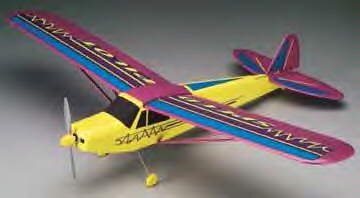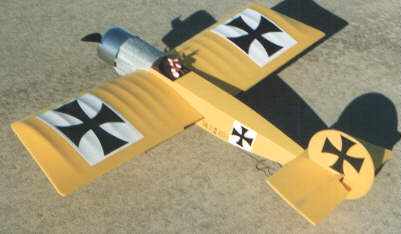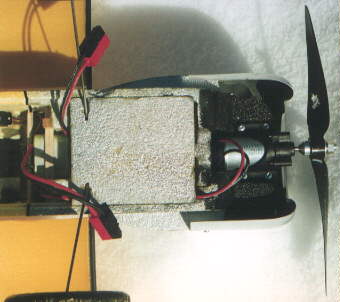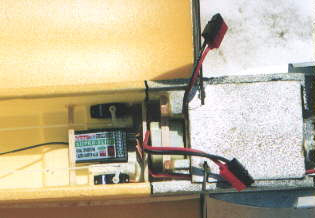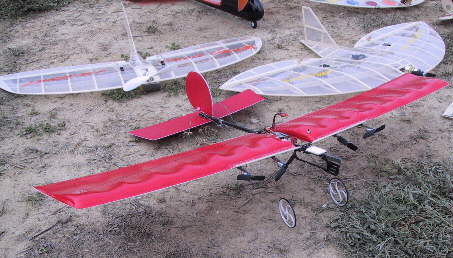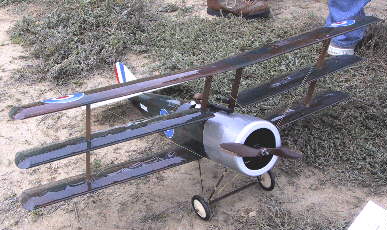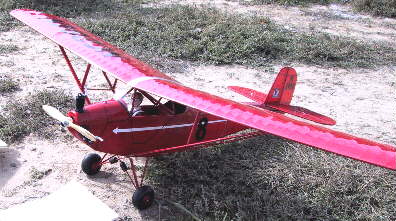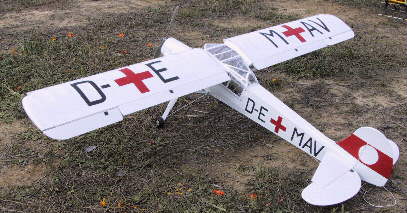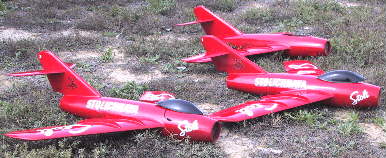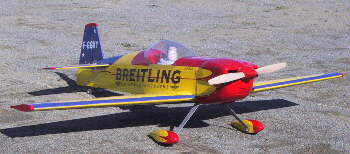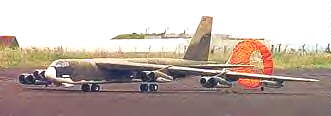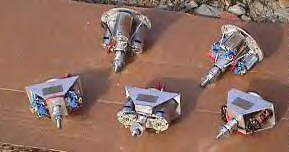 |
Flying High With Electric Power!
The Ampeer ON-LINE!
Fly the Future - Fly Electric! |
Site Table of Contents
| President: | Vice-President: | Secretary/Treasurer: |
| Ken Myers | Richard Utkan | |
| 1911 Bradshaw Ct. | 240 Cabinet | |
| Walled Lake, MI 48390 | Milford, MI 48381 | |
| (248) 669-8124 | (248) 685-1705 | |
 | ||
| Board of Directors: | Board of Directors: | Ampeer Editor |
| Jim McNeely | Jeff Hauser | Ken Myers |
| 4733 Crows Nest Ct. | 18200 Rosetta | 1911 Bradshaw Ct. |
| Brighton, MI 48116 | Eastpointe, MI 48021 | Walled Lake, MI 48390 |
| (810) 220-2297 | (810) 772-2499 | (248) 669-8124 |
| Mailed Ampeer subscriptions are $10 a year US & Canada and $17 a year world wide. FREE on-line! | ||
| The Next Meeting: Date: Thursday, April 5 Place: Ken's house (see above for address) Time: 7:30 P.M. | ||
|
From: John Zook johnzook@voyager.net Hi Ken, and greetings to all members of your club. I live up north in Central
Lake...in Antrim county. I have been very interested in electric flight for the past couple of years. I have been able to obtain a
great deal of information from reading your online magazine. Currently I have a number of e-planes: Puddlemaster powered by
Magnetic Mayhem, Goldberg Mirage- MM w/ 2.5:1 Leisure box. A Beetween from MAN plans, and an electric LT-40 rebuilt
w/ Keller 5/50 motor w/ Graupner belt-drive are my other planes.
A SIMPLE - YET STYLISH - ELECTRIC AIRPLANE FOR BEGINNERS
If looking good while learning the basics of R/C flight is important to you, then the
FlyZone Speed Pilot RTF electric plane from Hobbico is the model that shares your views. It boasts a classic profile, along with
factory-built sections that assemble quickly without gluing, a very simple-to-operate 2-channel, 2-stick radio, and slow, steady
electric-powered flight. When you also consider the Speed Pilot's affordable price, you have the ideal aircraft for getting into
high-flying R/C action!
Specifications - Wingspan: 37.5 in (953mm) Wing Area: 213 sq in (13.7dm2) Flying Weight: 1.4 lb (635g) Wing Loading: 14.9 oz/sq ft (45g/dm2) Length: 29.5 in (750mm) Includes: 380-size motor, 2-channel 2-stick radio, auto cut-off, rechargeable NiMH battery, AC wall charger, 2 propellers, instructional video, tools Requires: 8 'AA' batteries for the transmitter HCAA2012 Speed Pilot EP RTF w/2-Channel Radio Retail $199.99 Visit the Hobbico world wide web site at: www.hobbico.com
10th international Cumulus E-fly-in, Nijmegen/Winssen, The Netherlands, September 2nd 2001 General
Safety
Facilities
Directions & maps
Information
More Thoughts on Wing Loading
Hi Ken, I had a look at the formulae that you published in the latest EFO newsletter. They
look pretty familiar in terms of the rules of thumb that Keith was talking about back in the 80s. However, since then we have
learned more about sizing models and of course we have brushless motors and 2400 cells, tiny powerful motors, speed controls
the size of stamp, EDFs with 140 watts/lb. etc.
Cheers,
Confusion on Fort Wayne Electric Meets this Summer
I've received questions regarding E-meets this summer, and I wanted to clarify things.
The original "Electri-Fly" will be held in August like it always is. It's sponsored by the Fort Wayne Flying
Circuits, and run by yours truly.
Pat Mattes Graupner Eindecker
In the February issue of the Ampeer, Joe Hass told of his finishing and changes to the Icarus Eindecker. He sent along several photos. I chose three that show the finished products, motor mounting and positioning of the R/C gear and motor battery. For full information on this version, check the February issue. I’d also like to remind you that Joe has a custom building service. If anyone is looking for a custom built aircraft give Joe a call at 248-601-1707 or e mail at joehass@cmconnect.net. Mid-Winter Electric Meet Report
The Mid-Winter Electric meet in San Diego took place during a four-day stretch,
February 16-19, and it proved to be quite a celebration of model flight. At one time, I counted over 220 models out in the ready
area and that num-ber expanded during the day.
That’s right, four little Kenway-type motors with tiny props turned this Stik into a weapon. Scale modeler par excellence Fred Harris turned up with the 400-powered Triplane (above) and a fine looking American Eaglet (below). One more in a long list of scale models was this Fieseler Storch by an unknown builder (above). For the amusement of the wild ones among us, the guys from K&A Models showed us what their splendid MIGs would do (and they did plenty) with their ducted fan propulsion (below). The demonstration they put on was beautiful to watch and hear. They operate out of Albuquerque and have a website, www.kamodels.com, which readers might want to visit to view their entire line of products. I don’t know who owned the Tiger Moth, but the large airplane itself was resting prior to flight. Another DeHavilland creation was to be seen on the field and it was a beautiful rendition of a Mosquito. For unknown reasons, it resisted flight even after at least three takeoff attempts. I suspect that it had not been flown prior to this time and was sorely in need of tweaking. The Terry, pictured above, was one of the prettiest I have seen of this very popular Graupner model. Almost invisible is the line formed for the ailerons. As one might suspect, someone brought a CAP 232 along for the ride and it was spectacular (below). This is but a small portion of eye-candy on display at the field. My advice is to get out of the winter’s cold and into sunny San Diego air next year at this time. My sincerest thanks to the members of the SEFSD and their sponsors who really know how to do it. All photos by Doug Ward. Help Bring Chris Golds' Big B-52 To America
Dear Fellow Modeler(s), Chris Golds’ eight-engine electric-ducted-fan model is a proven performer and
would be a magnet for attention wherever it’s displayed or flown, and donations to help with its acquisition and US logistical
support would be greatly appreciated. The primary goal of this project is to further demonstrate eflight’s unique capabilities in
America by flying this B-52 at prestigious events typically dominated by gas-powered or turbine-powered models-or even fly it at
full scale air shows-although electric-only events wouldn’t be fully excluded.
MODEL COST The initial costs for the model involve purchasing it ready to fly (approx. $3000) without electronic speed controllers, batteries, transmitter and receiver; transport from England to Cologne, Germany, (approx. $150); construction of a reusable freight container (minimum $260 depending on material used); and air freight from Cologne to Portland, Oregon (minimum $650). These initial costs total approx. $4060 and will certainly be a bit more after unexpected costs are totaled. Once in the United States, we will also need additional funding to transport, display and/or fly the model at distant places outside its hangar location, particularly if air freight transport is necessary. Outfitting and retrofitting costs, (e.g., speed controllers, batteries, changing wire connectors) and possible replacement parts will also eventually add to the cost. Chris Golds will not deliver the model and the buyer must pick it up, so I have arranged for Stephen Mettam, editor of Electric Flight International magazine, to deliver it to me in Germany. And at that time we will display it the 4 - 8 April at the world-class Dortmund Modeling Fair (Dortmund Intermodellbau-Messe). Ramoser Design + Technik in Germany, maker of the varioPROP, will construct the reusable freight container. I'll package the model in the container and then Air Logistics GmbH (Limited), a holding of Chapman Freeborn, will handle the air freight consignment from Cologne International Airport to Portland, Oregon. In Portland the model will be picked up and delivered to its nearby hangar. Air freight charges are handled on a volume weight basis, and because of the container’s anticipated size (approx. 2m x 1m x 90cm) it will have a minimum volume weight of 300kg, although the actual weight will only be about 60kg . HANGAR The Miniature Aviation Showcase, a model airplane museum at 3182 N.E. Rivergate Street in McMinnville, Oregon, will house the model. The new museum building has 3000 sq.ft. of display space for a storage selection of some 600 engines, 130 radios, and 100 models-make that 101 with the Buff. Although a minority, there are other electric flight models in the collection. A 450 ft. hard surface runway behind the museum is convenient for test flying. Mr. Noel Martin, owner of the museum, also runs Martin Innovative Technology Inc. that has a professional machine shop which may certainly come in handy. He can also provide local area ground transport, such as collecting the model at Portland International Airport. The Miniature Aviation Showcase will have posted hours for viewing once the new building is open, and for real airplane buffs, the real Spruce Goose is in its hangar at the Evergreen Aviation Museum less than a mile away. The AMA Museum in Muncie, Indiana, is also on the list for possible temporary hangar display. DISPLAY AND PROMOTION Team B-52 is: James Frolik, project orchestrator and director. Bob Benjamin, B-52 pilot and nationally ranked eflight scale modeler. Jerry Holcomb, B-52 pilot, U.S. Scale Masters eflight participant, and AMA Associate Vice President District XI. Noel Martin, museum owner and curator, and owner of Martin Innovative Technology Inc. All members will deal with logistics and maintenance, and as a committee Team B-52 will review flying or display opportunities. The basic field requirement for aerial demonstration is a minimum 400 ft. hard surface runway (e.g. paved or durable woven material, like industrial conveyor belt, and no dirt or raw earth), although the committee may consider runways with a very short and smooth grass surface. Demonstration at events that meet runway criteria and/or static display at modeling fairs is open to any event where: 1) Team B-52 has enough funds to transport the model or the host organization provides transport costs, and 2) in the case of static display at least one Team B-52 member is available to accompany the model, or, 3) in the case of aerial demonstration at least one Team B-52 pilot is available to fly the model. Flying preference will also be given to events with high public exposure. Initial plans are to display and fly the model at this year’s U.S. Scale Masters Qualifier and U.S. Scale Masters Finals at Lenhardt’s Air Park in Hubbard, Oregon. The air park is not far from the Miniature Aviation Showcase, so transport to and from these events would be easy. The MAS also exhibits at the Portland Oregon Rose Festival Air Show, the largest air show in the Pacific Northwest. We don’t know yet if the Buff can fly there, but we can certainly display it. Demonstration at Top Gun 2002 is a real likelihood. Frank Tiano, Top Gun’s director, is interested in hosting a B-52 performance, but he can’t make a final "yes" or "no" decision until it’s safely in the US and has flown. A radio-control X-15 rocket plane is also under consideration, and hopefully by then Team B-52 will have this model in the package to offer Top Gun. One of America's leading model aviation magazines will also publish a review of the B-52 and its stateside performance. DONATIONS We request individual donations in the amount of USD $25, $50 or more from within the North American continent including Hawaii, Puerto Rico and overseas US Armed Forces personnel with an APO address. Assuming the model's safe air freight arrival in the United States, then every donation of at least $25 will receive a Team B-52 photo printed on photographic paper using a high quality inkjet color printer. If there is enough donor participation, we will make every effort to produce an approximately 20 to 30-minute scratch-edit video for donations of $50 or more, but here we can offer no guarantees. It depends on the number of $50 donations; an estimated minimum of twenty $50 donations would justify video editing costs. Please have patience with a photo or any video effort, as the earliest availability would be after the U.S. Scale Master Qualifier event in early August. Of course higher donation amounts are also welcome. The initial campaign for donations extends until 31 March 2001, as these finances will help directly with the Buff’s purchase acquisition the first week of April. Donations received thereafter will be used for components and stateside logistics-speed controllers, transport, display and promotion costs, etc. We would also like to list all donors in a B-52 sheet brochure displayed at events and in the museum. (Donations of less than $25 will only receive printed mention.) IMPORTANT! All donors must accept that Team B-52 assumes no liability in this fund-raising endeavor. Donations are strictly voluntary and not tax-deductible. But, in the very unlikely event this acquisition does not take place, all donations will be returned and this solicitation will be retracted. If you’re interested in being a supporter, please make your donation check or money order payable to the Team B-52 Fund and mail to: Team B-52 Fund Columbia River Bank 723 N.E. Baker Street McMinnville OR 97128 You should also include the following with your donation, to help me compile a donors list: 1) the amount of your donation to the fund, 2) your regular postal address for any photo/video or for any returned checks, and 3) who the donation represents (e.g., Mr. Tom Smith in Anytown, USA; or Tom's Hobbies in Anytown, USA; or the Electric Aces R/C Club in Anytown, USA, etc.). Team B-52 thanks you in for your interest in this project. Now, let's get this Buff off the ground! Sincerely yours, James Frolik (All information presented here, and the photo were from Jim’s Web site at: http://people.freenet.de/elflex/B-52_index.html km) One Thought On the X-250
Dear Ken, Here’s a thought on the SR Batteries X-250. All flying reports say that it needs
some down elevator trim, and/or forward CG. Mine behaved the same.
Team Gear UK Electric Flight Supplier
Ken, Nice to see someone else committed to electric flight, although my business does
also mean being involved with the glow planes as well.
Best Regards,
(I went to the site for the above photo and information on the team gear units. They look very interesting! :-) ) The Team Gear Range There are three twin engine units, the Sport twin which turns a 12x10, 13x10 or 14x7
prop and produces over 6 pounds of static thrust!!!! for a 7 to 10 minute flight.
Keith Shaw’s Estrellita Data
The Estrellita is 24" span, 120 sq.in., 10.5 oz. with dual-conversion receiver. Astro Flight 010 brushless, with 8 Sanyo 350AAC cells, Cam 4.7x4.7. About 12K @ 3.5amps, so output power is about 20 watts in the air. It does 6-7 minutes at full throttle (i.e. on), consecutive outside and inside loops, rolls, point rolls, rolling circle. I just wish I had put a functioning rudder on it! A Canadian Chimes in on the B-52 Project
(Around March 9, I tried to email those who I thought might be interested in donating to the B-52 project using the Ampeer mailing list and eliminating those addresses I knew were non-US. I did this because the time frame was crucial to the completion of the mission. A few of them did go to non-US addresses, and I never expected anyone would be interested. WRONG! It is a WORLD of eflight out there. Love you folks. :-) km) Hello Ken ..... Thanks for including me on the B-52 project. (I had a different email address
for him. km) While I am living in the Toronto area now the project brought back a lot of memories to me. In the late 1950's
I was living in Portland and that is when I started in R/C. I belonged to the "Stardusters" R/C club. I forget the exact
year, but we did put on a small contest at the McMinnville, Oregon airport. I have some 8 mm movies of that event and compared
to today's models and equipment it was very basic, but we had great fun learning the intricacies of single channel radios.
P.S. I just finished my Porterfield Collegiate and look forward to flying it as soon as we get some decent weather. I 'm attaching a scan of it. The March EFO Meeting The gathering turned out to be a bit smaller than anticipated. Seems that Gus, Wally
and Ken are all going through some personally very rough times.
The Upcoming April Meeting It was mentioned at the March meeting that the April meeting would be a flying meeting. This is not going to be the case. The April meeting will be held at Ken’s house on Thursday, April 5. Bring your new projects for show and tell. Where’s the Rest of the Article? Well, as you can see this was a pretty FULL issue, therefore the article will be continued in the May issue. To Reach Ken Myers, you can land mail to the address at the top of the page. My E-mail
address is:
KMyersEFO@aol.com
|
